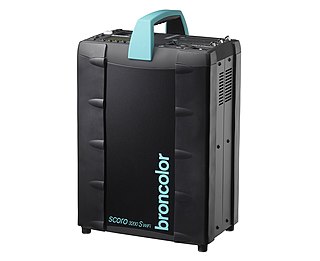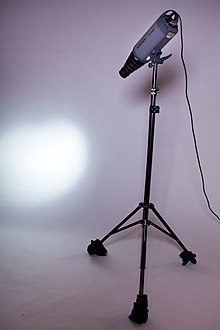
A flash is a device used in photography that produces a brief burst of light at a color temperature of about 5,500 K to help illuminate a scene. A major purpose of a flash is to illuminate a dark scene. Other uses are capturing quickly moving objects or changing the quality of light. Flash refers either to the flash of light itself or to the electronic flash unit discharging the light. Most current flash units are electronic, having evolved from single-use flashbulbs and flammable powders. Modern cameras often activate flash units automatically.

Underwater photography is the process of taking photographs while under water. It is usually done while scuba diving, but can be done while diving on surface supply, snorkeling, swimming, from a submersible or remotely operated underwater vehicle, or from automated cameras lowered from the surface.

A lateral buoy, lateral post or lateral mark, as defined by the International Association of Marine Aids to Navigation and Lighthouse Authorities, is a sea mark used in maritime pilotage to indicate the edge of a channel.

Macro photography is extreme close-up photography, usually of very small subjects and living organisms like insects, in which the size of the subject in the photograph is greater than life-size . By the original definition, a macro photograph is one in which the size of the subject on the negative or image sensor is life-size or greater. In some senses, however, it refers to a finished photograph of a subject that is greater than life-size.

A gobo is an object placed inside or in front of a light source to control the shape of the emitted light and its shadow.

Fill flash is a photographic technique used to brighten deep shadow areas, typically outdoors on sunny days, though the technique is useful any time the background is significantly brighter than the subject of the photograph, particularly in backlit subjects. To use fill flash, the aperture and shutter speed are adjusted to correctly expose the background, and the flash is fired to lighten the foreground.

In photography, a lens hood or lens shade is a device used on the front end of a lens to block the Sun or other light source(s) to prevent glare and lens flare. Lens hoods may also be used to protect the lens from scratches and the elements without having to put on a lens cover.
The geometry of a lens hood is dependent on three parameters: the focal length of the lens, the size of the front lens element and the dimensions of the image sensor or film in the camera.
In photography, through-the-lens metering refers to a feature of cameras whereby the intensity of light reflected from the scene is measured through the lens; as opposed to using a separate metering window or external hand-held light meter. In some cameras various TTL metering modes can be selected. This information can then be used to set the optimal film or image sensor exposure, it can also be used to control the amount of light emitted by a flash unit connected to the camera.

A lampshade is a fixture that envelops the lightbulb on a lamp to diffuse the light it emits. Lampshades can be made out of a large variety of materials like paper, glass, fabric, stone, or any material that let light in. Oftentimes conical or cylindrical in shape, lampshades can be found on floor, desk, tabletop, or suspended lamps. The term can also apply to the glass hung around many designs of ceiling lamp. Beyond its practical purpose, significant emphasis is also usually given to decorative and aesthetic features. A lamp shade also serves to "shade" human eyes from the direct glare of the light bulbs used to illuminate the lamp. Some lamp shades are also lined with a hard-backed opaque lining, often white or gold, to reflect as much light as possible through the top and bottom of the shade while blocking light from emitting through the walls of the shade itself. In other cases, the shade material is deliberately decorative so that upon illumination it may emphasize a display of color and light emitting through the shade surface itself.

Portrait photography, or portraiture, is a type of photography aimed toward capturing the personality of a person or group of people by using effective lighting, backdrops, and poses. A portrait photograph may be artistic or clinical. Frequently, portraits are commissioned for special occasions, such as weddings, school events, or commercial purposes. Portraits can serve many purposes, ranging from usage on a personal web site to display in the lobby of a business.

A lightbox is a translucent surface illuminated from behind, used for situations where a shape laid upon the surface needs to be seen with high contrast.

A ring flash is a circular light that is often operated with a camera lens in the center to take photographs. Unlike point light sources, a ring flash can illuminate a subject with minimal shadows by closely and evenly surrounding the optical axis of the camera lens. This makes it a popular choice for various types of photography, including macro, portrait and fashion photography.

In photography and cinematography, available light refers to any available source of light that is not explicitly supplied by the photographer for the purpose of taking pictures. The term usually refers to light sources in the surrounding environment that are present naturally or artificial lighting that are already pre-existing. It generally excludes flashes, although arguably flash lighting provided by other photographers shooting simultaneously in the same space could be considered available light. Light sources that affect the scene and are included in the actual frame are called practical light sources, or simply practicals.
Architectural photography is the subgenre of the photography discipline where the primary emphasis is made to capturing photographs of buildings and similar architectural structures that are both aesthetically pleasing and accurate in terms of representations of their subjects. Architectural photographers are usually skilled in the use of specialized techniques and cameras for producing such specialized photography.

In photography and cinematography, a reflector is an improvised or specialised reflective surface used to redirect light towards a given subject or scene.

Photographic lighting refers to how a light source, artificial or natural, illuminates the scene or subject that is photographed. Photographers can manipulate the positioning and the quality of a light source to create visual effects, potentially changing aspects of the photograph such as clarity, tone and saturation to create an accurate rendition of the scene.

LED art is a form of light art constructed from light-emitting diodes. LEDs are very inexpensive to purchase and have become a new way to make street art. Many artists who use LEDs are guerrilla artists, incorporating LEDs to produce temporary pieces in public places. LEDs may be used in installation art, sculptural pieces and interactive artworks.
Elinchrom LTD is a Swiss company manufacturing flash equipment and light shaping tools for professional photographers. The company was founded in 1962 in Renens, Switzerland.

Bron Elektronik is a manufacturer of flash equipment for photography and videography. It is located in Allschwil in Switzerland. Bron manufactures the broncolor lines of strobes, which include studio lighting systems with separate power packs and heads, as well as monolights. Both lines include light modifiers. The Focal Encyclopedia of Photography describes broncolor as "the leading Swiss manufacturer" of generator flash systems.
Stage lighting accessories are components manufactured for conventional (non-automated) stage lighting instruments. Most conventional fixtures are designed to accept a number of different accessories designed to assist in the modification of the output. These accessories are intended to either provide relatively common functionality not originally provided in a fixture, or to extend the versatility of a lighting instrument by introducing features. Other accessories have been designed to overcome limitations or difficulties some fixtures present in specific applications.
















